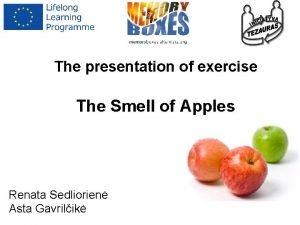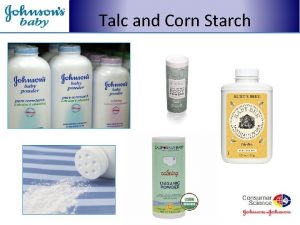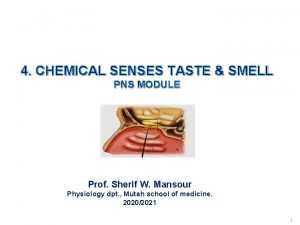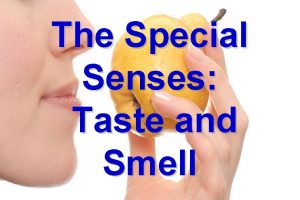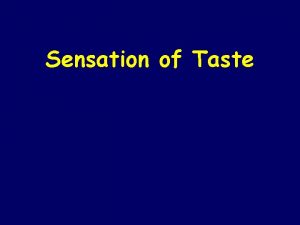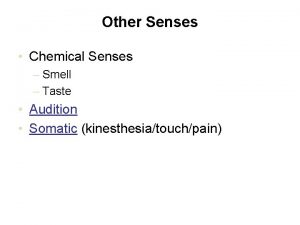4 CHEMICAL SENSES TASTE SMELL PNS MODULE Prof









- Slides: 9

4. CHEMICAL SENSES TASTE & SMELL PNS MODULE Prof. Sherif W. Mansour Physiology dpt. , Mutah school of medicine. 2020/2021

OLFACTION (SMELL SENSATION) Although the healthy person can discriminate more than 10, 000 different odors, yet smell sensation is not highly developed in human as in many animals. Significance of Smell Sensation 1 - It is closely related to taste sensation so in severe rhinitis (inflammation of the nose) many foods loose their specific taste. 2 - The receptors of olfaction are chemoreceptors and they are true neurons and it is said that the olfactory mucosa is the site in which nervous system is the nearest to the external environment. 3 - Olfactory sensations produce many effects in other organs e. g. they stimulate sexual derive. Olfactory sense is more highly developed in females than males and it is most sensitive at time of ovulation. 4 - Olfactory sensations either stimulate or inhibit gastro- intestinal secretion and motility. 5 -Smell sensations produce psychogenic effects e. g. sensations of pleasure in response to pleasant odorous as perfumes. 6 -Smell sensation has protective function because they inform us about dangerous odors like gases or fire. Olfactory Mucosa It lies in the roof of the nasal cavity near the septum (on the superior conchea) covering an area of about 6 cm 2 and is characterized by being yellowish pigmented area and by containing tubular Bowman's glands beside absence of the rhythmic movement of the cilia which characterized normal respiratory mucous membranes. The olfactory mucosa contains three types of cells: 1 - Receptor cells which are true bipolar neurons from 10: 20 millions in number having short thick dendrites with an expanded end called the olfactory rod from which cilia project to the mucous surface of the nasal cavity. The axons of the olfactory neurons penetrate the cribriform plate of the ethmoid bone to enter the olfactory bulb starting then olfactory pathway. These receptor cells are derived originally from the C. N. S itself. . 2 - Supporting cells or sustentacular cells with the Bowman's gland secrete a mucous layer. 3 - Stem cells or basal cells from which new receptor cells regenerate by mitosis. - Any substance to be able to stimulate olfactory receptors must be volatile to come in contact with olfactory epithelium and also it must be both water and lipid soluble to be dissolved in the thin mucous layer overlying these olfactory receptors and to cross the cell membrane.

Mechanism of Olfactory Receptors Stimulation -The resting membrane potential of the olfactory receptors is about -55 mv and at this level continues impulses are emitted from these receptors at a rate of 1: 3 / second. - Stimulation of olfactory receptors by odorant substance decrease this potential from -55 to -30 mv and this can increase number of impulses up to 20/second. - When the odorant substances come in contact with the olfactory area they diffuse into mucous layer and bind with the receptor protein on cilia. - Such binding will activate G protein with subsequent activation of adenyl cyclase enzyme leading to increase concentration of cyclic AMP which opens Na+ channels resulting in depolarization (receptor potential). - Chemical theory of olfaction : binding of odorant substances to the binding proteins transform simply these cilia into channels which admit Na+ influx and depolarization of the receptors. - The physical theory of olfaction : It was observed that many substances which have different chemical properties but have identical molecular shape, have the same odor. There about 100 types of receptor sites for the different odors on the cell membrane of the olfactory receptors. Each odor is thought to join one or more of these sites according to the shape of its molecule and this binding causes stimulation of the receptor.


Olfactory Pathway - The receptor cells in the olfactory mucosa are considered the first order neurons. Their axons unit to from the olfactory nerve (the first cranial nerve), these axons penetrate the cribriform plate of the ethmoid bone to enter the olfactory bulb. -The second order neurons in the olfactory pathway are characteristic cells called "mitral and tufted cells “ which are present in the olfactory bulb and they synapse with axons of olfactory cells forming the "olfactory glomeruli. - In addition to mitral and tufted cells, the olfactory bulbs contain peri-glomerular cells, which are inhibitory neurons connecting one glomerulus to another, and granule cells, which have no axons and make reciprocal synapses with the lateral dendrites of the mitral and tufted cells. -The olfactory glomeruli demonstrate lateral inhibition mediated by peri-glomerular cells and granule cells. This sharpens and focuses olfactory signals. It is believed now that different glomeruli respond to different odors. -The axons of tufted and mitral cells pass posteriorly to form the olfactory tract which enter the brain at the junction between the mesencephalon and the cerebrum, then divides into three stria: I - The medial stria which cross to the opposite side in the midline in the anterior commeasure. 2 - The lateral stria which terminates in prepyriform, pyriform Cortex and amygdaloid nuclei. 3 -Intermediate stria which terminates in olfactory tubercle within the anterior perforated substance and other group of nuclei located anterior to the hypothalamus. - It is believed that the olfactory pathway is the only sensory pathway which does not relay in the thalamus.

TASTE SENSATION (GUSTATION) Importance of Taste Sensation 1 -It is the first line of defense against toxic, putrefied or undesirable food. 2 -It evokes a reflex stimulation of salivary, gastric and even other gastrointestinal secretions to deal with the food, also increases G. I. T. motility. 3 -It causes psychic happiness with pleasant tasty food. 4 -It can play a role in homeostasis because a deficiency in certain mineral or vitamin makes us to seek for the food which is rich in that substance e. g. a pregnant women that suffer from Ca 2+ deficiency always craving for chalky substances or even mud to replace Ca 2+ deficiency Also, diabetic patients who lose much glucose in their urine always seek for food that contain "much sugar" while patients with a Addison's disease prefer salty foods because excessive loss of Na. Cl in their urine. The taste receptors are found in the "taste buds". They are a type of chemoreceptors that are stimulated by food or other substances that dissolve in the saliva of the buccal cavity. Although the tongue is known as the organ of taste yet the taste buds are concentrated mainly in the dorsum and sides of the tongue where as the lower surface of the tongue, mucosa of the cheeks, lips and rest of buccal cavity are nearly devoid of any taste buds. Some scattered taste buds are also present in soft and hard palate, epiglottis and in the pharynx. In infants and young children taste buds occupy larger area; in the tongue and may cover-the whole dorsum of the organ and even are found in buccal mucosa but they are progressively decrease with advancing age.

The Primary Taste Modalities -In human there are five basic taste modalities i. e. sweet, sour, bitter, salt and Umami meaty taste. Any other taste sensation is a mixture by different degrees of these five types. 1 - The classical stimulus for sweet sensation is organic sugars e. g. glucose sucrose and fructose. Sweet taste is best felt at the tip of the tongue. It cause an increase in the intracellular c. AMP which reduces K+ conductance resulting in production of the generator potential. 2 - Bitter taste can be evoked by quinine, strychnine and caffeine. . Bitter tastes are ideally felt at the dorsum of the tongue. Bitter taste lead to activation of phospholipase C which increase Ca 2+ inside the cells. 3 - Salt sensation can be given by ionized substances e. g. Na. Cl and is better felt at the anterior part of the dorsum of the tongue. Salt receptors are stimulated by Na+ influx through passive ungated channels in the receptor's membrane causes depolarization. 4 - Sour (acidic) taste is due to H+ ion and the more the ionization of the substance the stronger its acidic tasty sensation. Sour sensations are better felt at the edges of the tongue. It cause depolarization to the receptors via activating H+ gated cation channels leading to blockage of K+ channels. 5 - Umami meaty taste is triggered by amino acids, glutamate and particularly by monosodium glutamate. It is felt at the dorsum of the tongue. It is due to activation of metabotropic glutamate receptors and ionotropic glutamate receptors to depolarize Umami receptors. - Smell sensation and heat greatly increase taste sensations.

Pathway of Taste Sensation Taste sensation from the anterior 2/3 of the tongue are carried by the chorda tympani which is a branch from the facial nerve. The cell bodies of these nerve fibers are found in the geniculate ganglia these fibers then ascend and terminate in the upper part of nucleus solitarius of the medulla. Taste sensation from the posterior 1/3 of the tongue are carried by the branches of the glossopharngeal nerve. Their cell bodies are found in the petrosal ganglia. They ascend to synapse with the second order neurons in the middle part of the nucleus solitarius. Any taste sensation from any site other tongue are carried by sensory afferents from the vagus nerve. They terminate to synapse with second order neurons in the lower part of the nucleus solitarius. Axons of the second order neurons in the nucleus solitarius ascend in the ipsilateral medial lemniscus which is ended in the posterior ventral nucleus of the thalamus which form the third order neurons. Axons of the third order neurons runs in the sensory radiation to reach the anterior insula and the frontal operculum in the ipsilateral cerebral cortex. This region is close to the face area of the postcentral gyrus. - The lingual nerve (branch of the trigeminal nerve) carries the general sensation like pain, touch, temperature from the anterior 2/3 of the tongue while the glossopharngeal nerve innervates the posterior third. 3 rd order n. 2 nd order n.

Thank You








